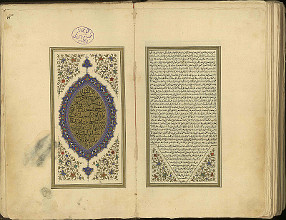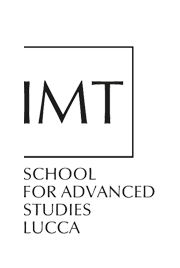Methodology
A Three-Step Plan

End of Ilāhiyyāt
Ms. Tehran, Kitābḫānah-i Maǧlis-i Shūrā-yi Millī (now: Kitābḫānah-i Maǧlis-i Shūrā-yi Islāmī = Parliament Library), 135
Each of the three main objectives/parts of the project will be attained through a series of successive steps. In each case, the initial step (.1) will be realized within the first phase of the project (months 1-30). The material information acquired during this phase will allow a sensible decision about whether the project should stop at its second step (.2), or may continue towards its third and final step (.3), once this latter will be judged feasible within the planned time framework. The intermediate second step, in any case, will represent a fully satisfactory end result, which will mark a substantial progress with respect to the current state-of-the-art; it will be perfectly congruent with the chosen procedures of online publication of the results, and susceptible to be brought to full completion with a reasonably short period of further research.
(M1.1) A first provisional list of manuscripts containing the Ilāhiyyāt is already available (see the section "Manuscripts"). Of these codices, the process of acquisition of copies and description is in progress. The production of the software deputed to their storage is almost completed.
(M1.2) A systematic inventory of the available manuscripts worldwide will provide a complete census. The description of codices will be comprehensive, but publication of images will be selective, i.e. limited to their most significant sections (incipits, colophons, folia with marginal glosses etc.).
(M1.3) Depending on the agreements reached with the concerned libraries, and in compliance with copyright and ownership regulations, the census and description of codices will be accompanied by a digital library containing integral reproductions of each of them.
(M2.1) A complete transcription of the text of the Ilāhiyyāt as preserved in MS. Oxford, Bodleian Library, Pococke 125 – one of the most ancient and best preserved codices of the work – is in preparation. The transcription of this manuscript will serve as basis for the collation, and it will be published in a section ("Text") of the present website. Depending on the number of the work’s manuscripts that the project will bring to light, and on the amount and frequency of the variations that they will convey, this first step of the editorial process can progress into either of the following types of edition (in an ascending order of completeness and perfection):
(M2.2) An edition based on a limited sample of codices, chosen according to a clear-cut chronological criterion of ancientness (for instance: until x centuries after Avicenna’s death), provided that all the main geographical areas of production of codices of the Ilāhiyyāt will be represented. In this way, the collation will be restricted to a tractable group of good codices and will be accomplished on selected passages of the work. External criteria for the classification of manuscripts into families (like the presence or absence of tables of contents etc.) can be adopted.
(M2.3) A full-fledged critical edition, in four phases. (A) The first phase of the recensio will be the preparation of a complete inventory and an accurate description of the six types of relevant witnesses, namely: (i) manuscripts; (ii) translations (like the Latin Medieval version); (iii) ancient printings (like the Tehran lithograph); (iv) parallel passages in other works by Avicenna; (v) commentaries by subsequent authors; (vi) indirect tradition, i.e. quotations/adaptations in later philosophers. (B) The next phase will be the eliminatio codicum descriptorum (of types i-iii of the witnesses, with the Tehran lithograph taken into consideration like a manuscript). Due to the huge number of codices, all dated manuscripts originating from the 19th century and later will be eliminated in advance. For the same reason, and due to the comprehensiveness of the text, the elimination of witnesses will have to rest on test collations of extensive, but selected, sections, i.e. of treatises I, V, and X. (C) The further phase will consist of a complete collation of all remaining manuscripts, of fixing major branches and reconstructing sub-archetypes, and of establishing a stemma codicum. (D) The final phase will be the examinatio and constitutio textus based on the results of the recensio. The method to be followed in this phase will depend on whether the recensio will bring to light one, two or more sub-archetypes. In cases where conjectures have to be made, the witnesses of types iv-vi, and possible emendations proposed in the current printings, will come into play. The method to be followed in the apparatus criticus is not yet predictable, as it depends on the results of recensio and examinatio: in general, in view of the huge number of manuscripts, all variant readings of eliminated witnesses and rejected sub-variants (below the level of sub-archetypes or variant-carriers) will not be included. The edition will encompass a philological preface, containing the stemma codicum, the description of the selected manuscripts, and the editorial principles.
Regardless of the chosen type of edition of the Arabic text, the facing translation will be in English, in order to ensure to the edition the widest possible diffusion. The translation will be literal, rather than aiming at rhetorical elegance, in strict consistency with Avicenna’s terminology, with additional notes on loci suspecti and cruces of the manuscript tradition, in order to make these cases also accessible to the non-Arabists. It will be articulated according to the main parts of Avicenna’s argument in each chapter, with explanatory subheadings marked as such and numbered sequentially, and marginal page concordance referring to the Cairo edition and, possibly, to the main manuscripts. A revised version of M. E. Marmura’s English translation can be used for this task, integrated with the divisio textus and the paragraphing of the Proponent’s Italian translation.
The running commentary will be both philosophical and philological. In its philosophical aspect, it will aim at presenting the immanent philosophical explanation of Avicenna’s doctrines, pointing out their historical sources and, as much as possible, their later reception in Arabic and Latin. It will refer systematically to the relevant secondary literature.
The indexes and lexica will consist of: Index rerum, Index nominum, Index locorum for text, translation and commentary; Arabic-Latin-English glossary, Arabic-Greek glossary for quotations of Aristotelian texts.
(M3.1) The codicological database, the bibliographical archive, and the mailing-list are in preparation. The codicological database will allow a double kind of search: search of single manuscripts, in order to display their content, basic description, and relevant images; search of single sections of the Ilāhiyyāt (treatises or chapters) and of other portions of the Shifa’, in order to signal how many manuscripts convey the regarded section, and which of them have already been used in previous printings.
(M3.2) The codicological database and the digital edition will be brought to their intermediate stage (see above, M1.2 and M2.2). The bibliographical archive will include publications regarding the Ilāhiyyāt alone.
(M3.3) The images of codices stored into the database can include not only the most relevant parts of the listed manuscripts, but also their integral reproductions in a Digital Library (see above, M1.3). The critical edition may acquire a larger extent (see above M2.3). The bibliographical archive can be extended to other works of Avicenna, and incorporate also the PDFs of the recorded items. To the mailing-list, a blog can be added.
Philosophy on the Border of Civilizations and Intellectual Endeavours:
Towards a Critical Edition of the Metaphysics (Ilâhiyyât of Kitâb al-Šifâʾ) of Avicenna (Ibn Sînâ)
ERC Advanced Grant 339621
Scuola Normale Superiore, Pisa, Italy
Piazza dei Cavalieri, n. 7
IMT School for Advanced Studies, Lucca, Italy
Piazza S. Ponziano, n. 6
Mail: info@avicennaproject.eu



